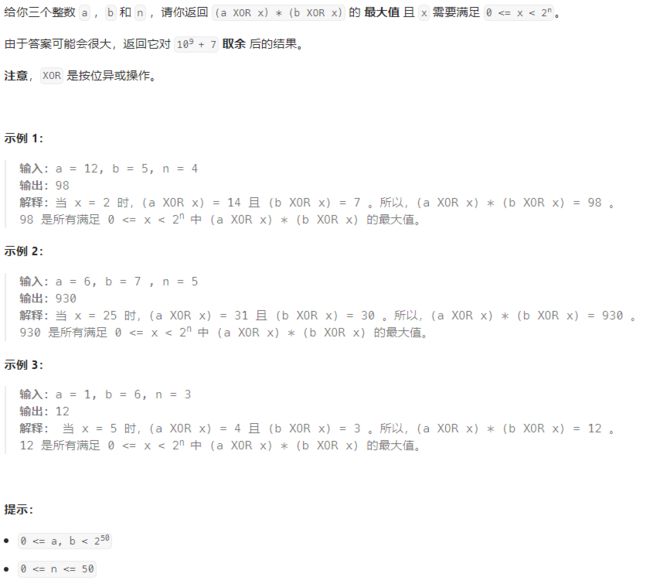第 372 场 LeetCode 周赛题解
A 使三个字符串相等
求三个串的最长公共前缀
class Solution {
public:
int findMinimumOperations(string s1, string s2, string s3) {
int n1 = s1.size(), n2 = s2.size(), n3 = s3.size();
int i = 0;
for (; i < min({n1, n2, n3}); i++)
if (!(s1[i] == s2[i] && s2[i] == s3[i]))
break;
if (i == 0)
return -1;
return n1 + n2 + n3 - i * 3;
}
};
B 区分黑球与白球
双指针:一个指针 i i i 遍历字符串,一个指针 j j j 指向下一个 0 0 0 应该移动到位置, i i i 指向 0 0 0 时更新答案同时 j + 1 j+1 j+1
class Solution {
public:
long long minimumSteps(string s) {
long long res = 0;
for (int j = 0, i = 0; i < s.size(); i++)
if (s[i] == '0') {
res += i - j;
j++;
}
return res;
}
};
C 最大异或乘积
贪心:从高到低枚举二进制每一位 i ∈ [ 0 , n ) i\in [0,n) i∈[0,n),有两种情况:
1) a a a 和 b b b 这一位相同,则存在 x x x 使得 a ∧ x a\wedge x a∧x 和 b ∧ x b\wedge x b∧x 这一位都为 1 1 1 ;
2) a a a 和 b b b 这一位不同,则 a ∧ x a\wedge x a∧x 和 b ∧ x b\wedge x b∧x 中只有一个数这一位为 1 1 1 ,若当前 a ∧ x a\wedge x a∧x 不考虑这一位的数大于 b ∧ x b\wedge x b∧x 不考虑这一位的数时,这一位 1 1 1 应该给 b ∧ x b\wedge x b∧x ,否则给 a ∧ x a\wedge x a∧x
class Solution {
public:
using ll = long long;
int maximumXorProduct(long long a, long long b, int n) {
ll mod = 1e9 + 7;
ll na = a, nb = b;
for (ll i = n - 1; i >= 0; i--)
if ((na >> i & 1LL) == (nb >> i & 1LL)) {
na |= 1LL << i;
nb |= 1LL << i;
} else {
if ((na & (~(1LL << i))) > (nb & (~(1LL << i)))) {
nb |= 1LL << i;
na &= ~(1LL << i);
} else {
na |= 1LL << i;
nb &= ~(1LL << i);
}
}
return (na % mod * (nb % mod) % mod + mod) % mod;
}
};
D 找到 Alice 和 Bob 可以相遇的建筑
二分+线段树:对于一个查询 [ a , b ] [a,b] [a,b] ( a ≤ b ) (a\le b) (a≤b) , 有三种情况:
1) a = = b a==b a==b,答案为 a a a
2) a ≠ b a\ne b a=b ,且 h e i g h t s [ a ] < h e i g h t s [ b ] heights[a] < heights[b] heights[a]<heights[b] ,答案为 b b b
3) a ≠ b a\ne b a=b ,且 h e i g h t s [ a ] ≥ h e i g h t s [ b ] heights[a] \ge heights[b] heights[a]≥heights[b],答案为满足 m a x { h e i g h t s [ k ] ∣ k ∈ [ b + 1 , i ] } > h e i g h t s [ a ] max\{heights[k]\;|\; k \in [b+1,i] \}\; >heights[a] max{heights[k]∣k∈[b+1,i]}>heights[a] 的最小的 i i i ,通过线段树来维护区间最大值,然后通过二分求 i i i
class SegmentTree {
public:
typedef long long ll;
inline void push_down(ll index) {
st[index << 1].lazy = 1;
st[index << 1 | 1].lazy = 1;
st[index << 1].mark = max(st[index << 1].mark, st[index].mark);
st[index << 1 | 1].mark = max(st[index << 1 | 1].mark, st[index].mark);
st[index << 1].s = max(st[index << 1].s, st[index].mark);
st[index << 1 | 1].s = max(st[index << 1 | 1].s, st[index].mark);
st[index].lazy = 0;
}
inline void push_up(ll index) {
st[index].s = max(st[index << 1].s, st[index << 1 | 1].s);
}
SegmentTree(vector<int> &init_list) {
st = vector<SegmentTreeNode>(init_list.size() * 4 + 10);
build(init_list, 1, init_list.size());
}
void build(vector<int> &init_list, ll l, ll r, ll index = 1) {
st[index].tl = l;
st[index].tr = r;
st[index].lazy = 0;
st[index].mark = 0;
if (l == r) {
st[index].s = init_list[l - 1];
} else {
ll mid = (l + r) >> 1;
build(init_list, l, mid, index << 1);
build(init_list, mid + 1, r, index << 1 | 1);
push_up(index);
}
}
ll query(ll l, ll r, ll index = 1) {
if (l <= st[index].tl and st[index].tr <= r) {
return st[index].s;
} else {
if (st[index].lazy)
push_down(index);
if (r <= st[index << 1].tr)
return query(l, r, index << 1);
else if (l > st[index << 1].tr)
return query(l, r, index << 1 | 1);
return max(query(l, r, index << 1), query(l, r, index << 1 | 1));
}
}
private:
struct SegmentTreeNode {
ll tl;
ll tr;
ll s;
ll mark;
int lazy;
};
vector<SegmentTreeNode> st;
};
class Solution {
public:
vector<int> leftmostBuildingQueries(vector<int> &heights, vector<vector<int>> &queries) {
int n = heights.size();
SegmentTree stree(heights);
vector<int> res;
res.reserve(queries.size());
for (auto &qi: queries) {
int a = min(qi[0], qi[1]), b = max(qi[0], qi[1]);
if (a == b)
res.push_back(a);
else if (heights[a] < heights[b])
res.push_back(b);
else {//ha>hb
int l = b + 1, r = n;
while (l < r) {
int mid = (l + r) / 2;
if (stree.query(b + 1 + 1, mid + 1) > heights[a])
r = mid;
else
l = mid + 1;
}
if (l < n)
res.push_back(l);
else
res.push_back(-1);
}
}
return res;
}
};



